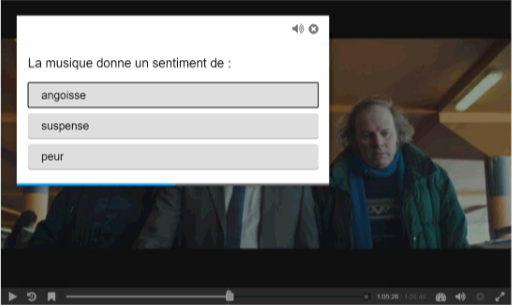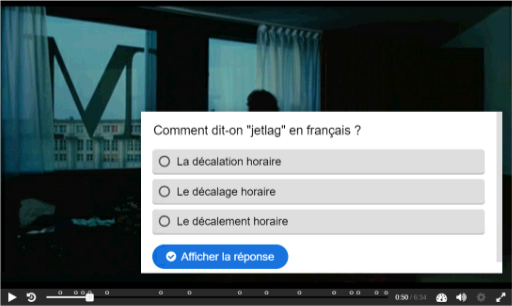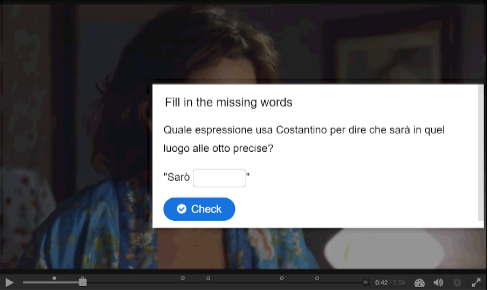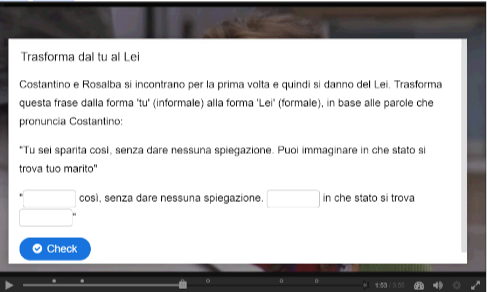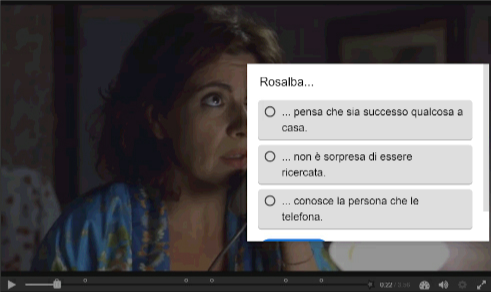Learning from movies with H5P


H5P is an online tool that allows teachers to create interactive content. In the ETC bachelor program, movies are used as input and to introduce a new theme in language proficiency courses. While they watch movies, we want students to pick up on some linguistic or cultural aspects. To do so, we process fragments from the movies with interesting content in H5P and turn them into interactive videos. As the student is watching, the fragment pauses, and a question pops up.
It can be any kind of question as the program allows many sorts of interactions: add a table, image, link, or ask questions such as statements, multiple-choice, true/false, drag and drop, mark words …
H5P in French courses
Our students like to work on the fragments as they receive direct feedback on their answers. It helps them identify useful combinations of words they will be able to actively use in the following language task. It helps teachers to be sure students notice certain cultural aspects that can be used later in the synchronous class to start a discussion while being sure everyone is on the same page. Furthermore, the possibility to jump back in the video and rewatch a particular part of the scene, until a correct answer is provided, is a useful tool to enhance close listening.
Here are some examples from the movies Bienvenue chez les Ch’tis (2008), Paris, je t’aime (2006) and Le grand bain (2018).
After a trial period, H5P has been implemented into Nestor and activities can now be added directly in the course. As an H5P activity is created, an additional column appears in the Grade Center displaying the scores of students for each fragment providing insight into students performance.
H5P in Italian courses
In Italian classes, H5P is used mostly for interactive videos in relation to the film program that is being offered in the courses. In addition to the viewing of films and preparation on tasks related to them, students are required to carry out activities on movie fragments through H5P. The focus on particular cultural and linguistic aspects in movie scenes, and the possibility to offer interactive content with H5P, has increased students’ engagement with movies in comparison to previous years. The most positive aspect of the Interactive Video function is the range of interactions that can be added to a film fragment; this gives the opportunity to vary the activities, also in connection with the learning outcomes of a course.
Here you can see some H5P examples related to a scene of the movie Pane e tulipani (Silvio Soldini, 2000), which is offered at the beginning of the course Italian 2a (CEFR level A2).
If students cannot provide all the correct answers immediately, the video will be rewinded and students can rewatch the relevant fragment. This benefits close listening. At times, students can skip a question, if it is too difficult - but teachers can also force the completion of each question. By now we mostly refrain from this latter option in order to not discourage students.
In general, we received positive responses about H5P from students.
In brief
Possible use cases. For languages: Adding interactions and information to videos, stories, images. But H5P offers many other possibilities that could prove useful to other kinds of courses. A few examples:
- Branching Scenario: Create dilemmas and self-paced learning;
- Course Presentation: Create a presentation with interactive slides;
- Arithmetic Quiz: Create time-based arithmetic quizzes;
- Timeline: Create a timeline of events with multimedia.
Advantages.
- Adds interaction with material;
- Quite intuitive;
- Integrated into Nestor (and the Grade Center);
- Created materials can easily be shared between teachers.

Disadvantages. When copying previous Nestor course modules, the H5P items need to be created again manually, because otherwise the link with the Grade Center will not work properly.
Costs. None for teachers or students. There is a licence for 50 teachers and 1000 students. Teachers who create an H5P item in Nestor automatically get an account.
Learning curve. To master the tool, teachers need to invest an approximate of two hours. Watching a few tutorials and then trying it out a couple of times should be sufficient.
Additional information
Would you like to explore H5P before using it in Nestor? Then create a free account at h5p.org. Items you create here can later be copied to the Nestor environment. With a free account you can upload videos of up to 16 MB (in Nestor this is 2GB!).
There is no RUG manual yet for using H5P in Nestor. However, the H5P website contains good manuals to get you started.
| Last modified: | 04 June 2021 12.04 p.m. |

